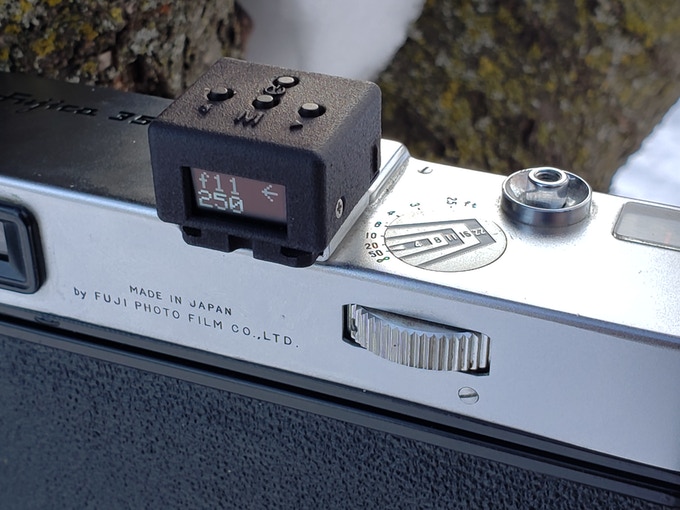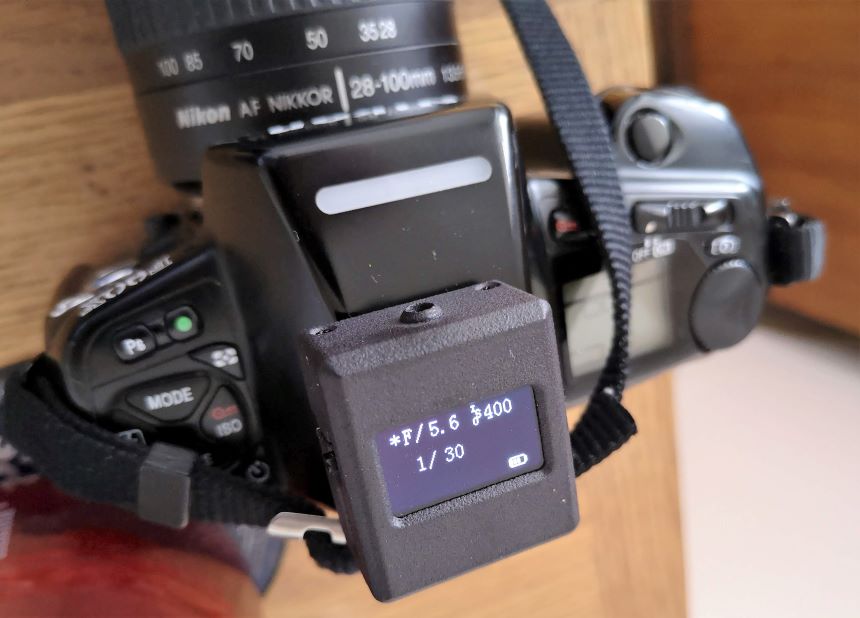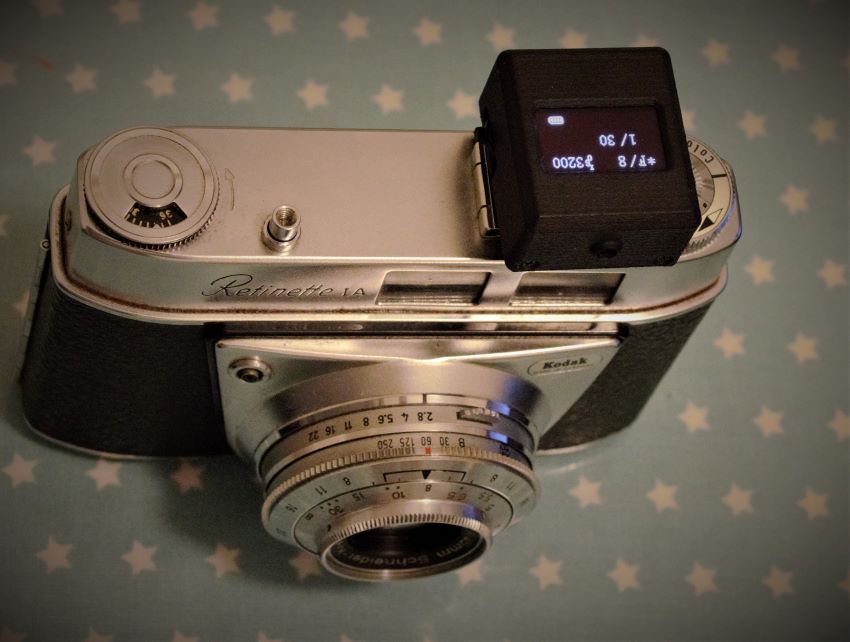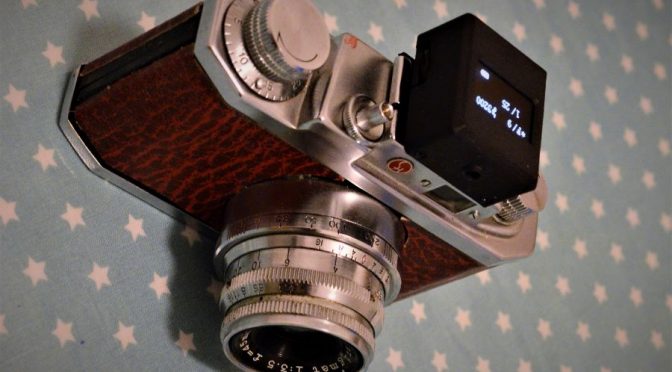Earlier this year, there was a bit of buzz with the Kickstarter launch of a new cold/hot shoe mountable mini light meter for vintage cameras. Trouble for the Reveni Labs Light Meter is that it isn’t the only product in the market place. But this cheaper rival has a huge issue
UPDATE – I’ve just published some real world field testing of this meter
I’m indebted to the great Johnny Martyr for picking this up. Clip on meters are not a new idea and have been around for decades. Top dog is arguably the Voigtländer VC series. The current VCII is still being sold new and will set you back well over £200 (Hamish Gill has a review of this wonderfully engineered thing on 35mmc)
 Voigtländer VCII on a Leica IIIC Gisling / CC BY-SA
Voigtländer VCII on a Leica IIIC Gisling / CC BY-SA
So Reveni’s proposition of a simpler, much cheaper meter with a 3d Printed body looks good. The problem is that there are already cheaper still meters on sale -notably the L-101 and our focus, the V-201X.

Kickstarter Cost inflation
Unless you were one of the just 25 early bird backers for the Reveni who paid just $100CAD, your Reveni will have set you back $125CAD (about $89USD). The L-101 and V-201X however in plastic bodies will set you currently back less than $50USD (or less than £40GBP)
Enter the Cheaper V-201X

The V-201X is also available in an alumium (silver or black) body for about £15-20 more. It is small unit with a hot/cold shoe mount underneath. The mount is not adjustable so may be an issue on some cameras shoe but I’ve yet to find one.
It is a no frills affair with just a on switch and a single toggle switch for adjusting settings. Pushing this switch in lightly switches between aperture and shutter speed being toggled. You can then adjust the selected value by moving the toggle switch forward or back giving you both a aperture priority or Shutter priority modes. Holding down the toggle switch for longer allows you to jump to the ISO setting.
Specification
- Power – Lithium Rechargeable via USB-C
- Charge Time – Purportedly 30 mins
- Battery life – Purported 24 hours in continuous use
- Aperture range – f/1 to f/32
- Shutter range – 1sec to 1/2000
- ISO range – 6-6400 ISO
- Angle of View – 30 degrees
- Screen – OLED

There is no manual in the bag only a USB-C cable (actually worth a few quid). Bear that in mind as the eBay listing actually has the instructions on it. In not quite perfect English…..
That said it is reasonably intuitive.
Interesting although both the ISO and aperture allow you to set not just full stop value but some intermediately settings, using the shutter mode only has full stop. Odd as when aperture is set fixed it will show intermediate shutter speeds
How does it compare to the Reveni ?
To be fair the Reveni offers a wider range of settings. But this is intended for a vintage camera. It’s not likely you’ll have a camera with a shutter speed of 1/8000. Granted if you are a pinhole shooter having a meter that can go down to f/1024 might be helpful – but I doubt it as the slow shutter speed range only goes to 8secs.
The Reveni also uses SR44 cell batteries – the V-201X has rechargeable lithium one. The Reveni also has a wider metering angle of 45 degrees – personally i think that’s worse and tellingly the Voigtländer VCII also has a 30 degree arc.
The OLED is also on the top plate of the V-201X not the rear as the Reveni. As we’ll see that is an issue. The V-201X shows all 3 values at the same time , the Reveni just shows 2.
So how does it work in practice ?

I did some testing with comparisons on my Nikon F90x, FE and D700. I also tested it against my Polaris digital meter and some android light meter apps that I find okay
The Good News is there metering….
The Metering is actually not bad.It was broadly as good as any of the hand helds in non complex situation. My polaris is probably the most accurate area meter I have and the scores often matched and if not there was only up to +/- 1 stop difference.
Shoving it on the various Nikon arguably pointless as it’s an area meter. The FE has Nikon’s legendary centre weighted TTL and the F90x and D700 got the benefits of full computer aided 3D matrix metering.
But again we got results that most of the time were within a stop provided you didn’t have a backlit subject. I used it against the FE with TMax P3200 loaded at dusk on a Corona approved dog walk and in dull daylight with Kosmo Foto Mono 100 being pushed @400ISO in the F90x. The meter was also extensively tested indoors on 100 ISO.
….. But that Screen
The bad news is that OLED screen.
Now you’d be forgiven for thinking that initially sounds cool. Organic LED screens are the buzz at the moment in monitor and TV tech. They do incredible blacks that no other LED/LCD tech can match. And that works great for yer Telly on a Saturday night watching Netflix.
But there’s a problem. The clue is in the initially rather ancient monochrome top plate LCD panels on my F90x and D700. This uses the same tech as my casio watch & first calculator back in the 1980’s. You’ll find similar panels on current models like the D850 or the Panasonic Lumix G9. And there is a reason.
Take these cameras outside and you can read that display easily even in bright light. Other LCD techs rely on reflected to varying extents. OLED produce the light. This means without various anti reflective or polarising filters OLED are hard to see in bright light.
The V-201X is definitely without those. The display is good indoor or inlow light but even in EV12 conditions I was struggling to read it. The Reveni may have an edge here if the panel is similar by being on the rear. I asked Matt from Reveni and he indicates there is no issue view it’s screen in bright light which would make it much more useful.
Conclusion
The V-201X in terms of metering does a good job costs half the price of the Reveni even with discount and looks better too. Granted the Reveni has a bigger range of setting but you’re really unlikely to need ’em. Where the Reveni might win out is the screen.
And for the V-201X is a shame as it’s pretty competent stuff otherwise (UPDATE – I’ve just published some real world field testing of this meter and it is pretty accurate)


What is the camera pictured at the top? (With the brown leather). How does it compare to free iOS apps like “Lux”? Thanks
The camera is a Halina 35X with a vinyl recoating. swapped back to android last year but used 2 free metering apps to match this off -David Quiles’s light Meter ( I recall i had that on my last iPhone too) and WB Photolab Lightmeter. Broadly comparable on area metering to the V-201X
Hi Alan – so do you have a recommended light meter app on Android?
What I would say Harry is that in my experience you can never guarantee an app thet will work across different phones. My main meter app is Light Meter Free by WBPhoto which as both a reflective and incident metering. This broadly comparable to my dedicated Polaris meter and centre weighted SLR measurements. It cant compete against matrix metered cameras for accuracy but even my handheld cant do that. However I used to use another App that was great on a prior Android and the iPhone I had in between. Just struggles on my new phone and I suspect the WBPhoto app will not work well on some phones.
Thanks Alan – I’ll give them a go – to be honest, it’s only to make an attempt to be a bit more consistent than guessing (I could pretend it’s the Sunny 16 rule, but I just guess and leave it to the film’s latitude to save me) 🙂
This is undoubtedly me not understanding the functions in an app, but I find it frustrating that I cannot fix the ISO and limit the other parameters to reflect the camera I’m using (say lowest shutter speed is 1/60th and highest is 1/200th; f stops between 4.5 and 16 etc.) I might be better off learning the exposure triangle better… lol
Thanks for the shout-out and in-depth review of a product that I’m sure many people will be curious about. Super informative!
Hey Alan, I too have this meter after discovering it on eBay and Johnny’s blog.
I wrote a post about it on my blog as well but my site is undergoing a redesign atm. Good to see someone else out there took a chance on it without there being much info on it. Cheers!
Hi Allan,
In all the Ebay offerings I have seen and also in your review only the setting range of aperture/time/ISO are mentioned. It would be intereting to know what the metering range of these light meters is and how accurate it is over this range. Is there any data avaiklable on that?